The Thermaltake Toughpower GF3 is an ATX v3.0 and PCIe 5.0 ready PSU with lots of power reserves and high performance. This is an ideal PSU for a super expensive NVIDIA RTX 4090, but there is a catch. Read the review to find out about that, I won’t offer any spoilers!
I have reviewed most of Thermaltake’s GF3 PSUs so far, the 750W, 850W, 1000W, and 1200W models, all of which are made by Channel Well Technology. The two highest capacity ones, 1350W and 1650W, are by a different OEM, High Power, and today I will look at the first to see how it compares against the competition by Antec, MSI, XPG, Silverstone, and other brands. Since there are not many 1350W PSUs, I had to use a wider Wattage range for my performance graphs, ranging from 1250W to 1350W. I left the 1500W and higher capacity PSUs for the GF3 1650W review.
The GF3 1350W is among the few high-capacity and Gold efficiency in the 80 PLUS scheme, PSUs. Usually stronger than 1000W, PSUs have Platinum or higher efficiency certifications to restrict thermal loads, which lead to high-speed fan operation and excess noise output. Although the GF3 1350W achieves Platinum efficiency in the Cybenetics scheme, its fan speed profile is tuned aggressively, so if you plan to push this unit hard, I suggest you buy good noise-canceling headphones and warn your neighbors. Since, in most cases, Platinum PSUs are expensive, the sweat spot for Gold units is at 1000W, where some quiet operating PSUs can be found. Take a look at the Cybenetics database before you proceed with a new PSU purchase, especially if you want to get a silent operating one.
- Manufacturer (OEM): High Power
- Max Power: 1350W
- Cybenetics Efficiency: [115V] Cybenetics Platinum (89-91%)
- 80 Plus Efficiency: Gold
- Noise: Cybenetics Standard (40-45 dB[A])
- Compliance: ATX12V v3.0, EPS 2.92
- Alternative Low Power Mode support: Yes
- Power 12V: 1350W
- Power 5V + 3.3V: 120W
- Power 5VSB: 15W
- Cooling: 140mm Hydraulic Bearing Fan [TT-1425 (A1425S12S-2)]
- Semi-Passive Operation: Yes (Selectable)
- Modular Design: Yes (Fully)
- High Power Connectors: 2x EPS (2x cables), 6x PCIe 6+2 pin (3x cables), 1x PCIe 12+4 pin (600W)
- Peripheral Connectors: 12x SATA (4x cables), 4x 4-pin Molex (single cable), 1x FDD adapter
- ATX/EPS Cable Length: 600/700mm
- Distance between SATA / 4-pin Molex connectors: 150mm
- In-cable capacitors: No
- Dimensions (W x H x D): 150 mm x 85 mm x 160 mm
- Weight: 1.84 kg (4.06 lb)
- Warranty: 10 years
Box & Bundle
I expected to find an enormous box for a 1350W PSU, but the unit’s dimensions are small, only 160mm in depth. So there is no need for a massive package. The box’s protection is good, with packing foam surrounding the PSU. The bundle includes a cable pouch, which will come in handy considering the vast number of modular cables.
Product Photos
Thanks to the normal footprint, it looks like an 850W or 1000W unit and not a 1350W monster. I am not fond of compact PSUs with high power output because this is usually bad news for noise output.
Cables
| Modular Cables | ||||
| Description | Cable Count | Connector Count (Total) | Gauge | In Cable Capacitors |
|---|---|---|---|---|
| ATX connector 20+4 pin (600mm) | 1 | 1 | 18AWG | No |
| 8-pin EPS12V (700mm) | 1 | 1 | 16AWG | No |
| 4+4 pin EPS12V (700mm) | 1 | 1 | 16AWG | No |
| 6+2 pin PCIe (500mm+150mm) | 3 | 6 | 16-18AWG | No |
| 12+4 pin PCIe (500mm) (600W) | 1 | 1 | 16-24AWG | No |
| SATA (500mm+150mm+150mm) | 4 | 12 | 18AWG | No |
| 4-pin Molex (500mm+150mm+150mm+150mm) | 1 | 4 | 18AWG | No |
| FDD Adapter (150mm) | 1 | 1 | 22AWG | No |
| AC Power Cord (1390mm) – C19 coupler | 1 | 1 | 16AWG | – |
Weirdly, High Power didn’t use 16AWG gauges on the ATX connector. Still, someone could argue that the power this connector delivers is restricted anyway since the PCIe slot cannot draw more than 5.5 Amperes from the 12V rail (66W) and the CPU socket gets most of its operating power from the EPS connector(s). The number of 6+2 PCIe is sufficient, given that there is a 12+4 PCIe rated/set at 600W. Lastly, the distance between all peripheral connectors is adequate, at 150mm.
Protection Features
| OCP (Cold @ 23°C) | 12V: 170A (151.11%), 11.913V 5V: 30.1A (125.42%), 5.014V 3.3V: 30.3A (126.25%), 3.357V 5VSB: 5.5A (183.33%), 4.937V |
| OCP (Hot @ 39°C) | 12V: 168A (149.33%), 11.926V 5V: 30.1A (125.42%), 5.015V 3.3V: 30.2A (125.83%), 3.361V 5VSB: 5.4A (180%), 4.938V |
| OPP (Cold @ 29°C) | 2025.21W (150.02%) |
| OPP (Hot @ 43°C) | 2003.57W (148.41%) |
| OTP | ✓ (171°C @ 12V Heat Sink) |
| SCP | 12V to Earth: ✓ 5V to Earth: ✓ 3.3V to Earth: ✓ 5VSB to Earth: ✓ -12V to Earth: ✓ |
| PWR_OK | Proper operation |
| NLO | ✓ |
| SIP | Surge: MOV Inrush: NTC Thermistor & Bypass relay |
OCP at 12V and OPP are notably higher than 130%, without any load regulation or ripple issues. I would like closer to 140% OCP at 12V, not 150%, especially at high operating temperatures. Thankfully, OCP on the minor rails is correctly set, below 130%.
Part Analysis
| General Data | |
| Manufacturer (OEM) | High Power |
| PCB Type | Double Sided |
| Primary Side | |
| Transient Filter | 4x Y caps, 2x X caps, 2x CM chokes, 1x MOV, 1x MPS HF81 (Discharge IC) |
| Inrush Protection | 1x NTC Thermistor SCK-057 (5 Ohm) & Relay |
| Bridge Rectifier(s) |
2x GBJ5006 (600V, 50A @ 100°C)
|
| APFC MOSFETs |
2x Infineon IPW60R060P7 (600V, 30A @ 100°C, Rds(on): 0.06Ohm)
|
| APFC Boost Diode |
1x Toshiba TRS12E65F (650V, 12A)
|
| Bulk Cap(s) |
2x Rubycon (420V, 680uF each or 1360uF combined, 2,000h @ 105°C, MXE)
|
| Main Switchers |
2x Infineon IPP60R060P7 (600V, 30A @ 100°C, Rds(on): 0.06Ohm)
|
| APFC Controller |
Infineon ICE3PCS01G
|
| Resonant Controller | Champion CU6901V |
| Topology |
Primary side: APFC, Half-Bridge & LLC converter
Secondary side: Synchronous Rectification & DC-DC converters |
| Secondary Side | |
| +12V MOSFETs | 8x Infineon BSC010N04LS (40V, 178A @ 100°C, Rds(on): 1mOhm) |
| 5V & 3.3V | DC-DC Converters: 8x Infineon BSC0906NS (30V, 40A @ 100°C, Rds(on): 4.5mOhm) PWM Controller(s): ANPEC APW7159C |
| Filtering Capacitors | Electrolytic: 5x Rubycon (3-6,000h @ 105°C, YXG), 1x Nichicon (4-10,000h @ 105°C, HE), 2x Rubycon (6-10,000h @ 105°C, ZLH), 2x Rubycon (4-10,000h @ 105°C, YXJ) Polymer: 20x FPCAP, 4x Nippon Chemi-Con |
| Supervisor IC | Weltrend WT7527RA (OCP, OVP, UVP, SCP, PG) |
| Fan Controller | STCmicro STC15W408AS |
| Fan Model | Thermaltake TT-1425 (A1425S12S) (140mm, 12V, 0.70A, Hydraulic Bearing Fan) |
| 5VSB Circuit | |
| Rectifier(s) |
1x Infineon IPN70R1K4P7S (700V, 2.5A @ 100°C, Rds(on): 1.4Ohm)
& 1x PFC P10V45SP SBR (45V, 10A)
|
| Standby PWM Controller | Si-Trend SI8016HSP8 |
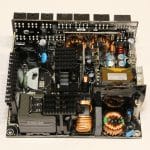
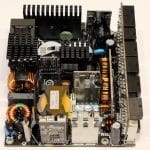
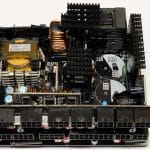
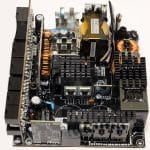
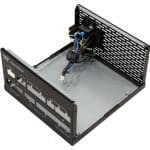

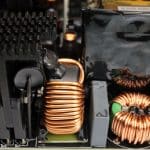
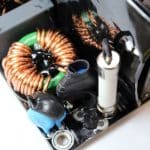
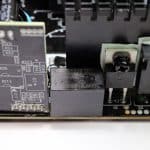
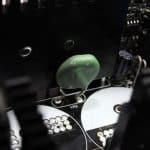
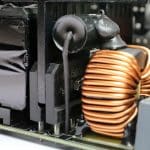
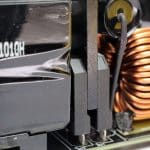
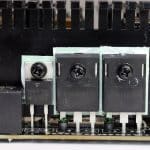
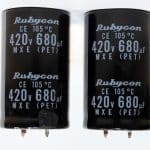
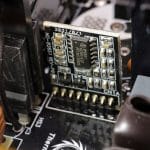
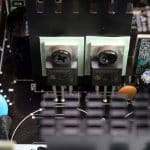
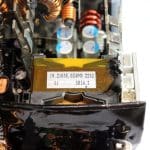
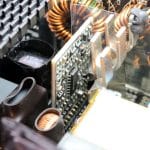
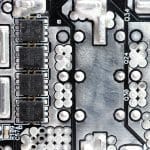
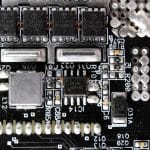
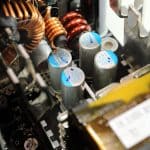
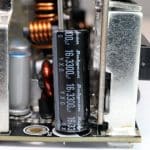

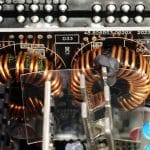

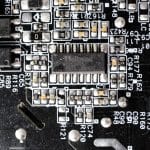
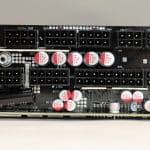

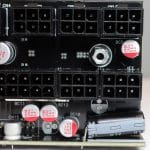
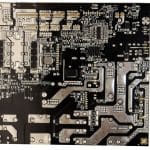

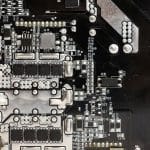
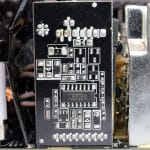


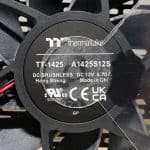
The OEM is High Power, and the platform uses good parts everywhere to offer high performance and reliability. On the primary side, we find a half-bridge topology, which looks out of place in such a high-capacity PSU. Typically, a full-bridge topology is used in above 1200W units, but the cost of the extra two FETs increases the production cost. Eight Infineon FETs regulate the 12V rail on the secondary side, and two DC-DC converters handle the minor rails. Lastly, the soldering quality is pretty good, and the HDB fan, which bears TT’s logo, is powerful! The small PCB is overpopulated with parts, so the fan has to push lots of air to offer a decent airflow.
Load Regulation
I would like to see within 1% load regulation at 12V.
Ripple Suppression
Ripple suppression is great!
Transient Response
Transient response is close to 1% at 12V, but a strong unit should easily achieve below 1% deviation on this rail. The minor rails have mediocre performance here.
Transient Response ATX 3.0 & 12VHPWR Connector Tests
The ATX v3.o spec allows up to 8% drop at 12V, meaning 11.04V, so the PSU successfully passes even the 200% transient response test. I would like to see at least 11.2V on the 12V rail in the worst-case scenario.
Hold Up Time
The hold-up time is long, and the power ok signal is accurate, but the DC Loss delay is much longer than required.
Timings
The PSU supports Alternative Low Power Modes.
Inrush Current
Inrush current is low at 115V and at normal levels with 230V for a 1350W unit.
Efficiency Normal, Light & Super-Light Loads
With 115V, the platform meets eye-to-eye with higher efficiency platforms at normal loads. It also fares well with light and super-light loads.
Average Efficiency 5VSB
The 5VSB rail is not efficient.
Vampire Power
Vampire power is low.
Average Efficiency
No wonder why this platform scores Platinum in the Cybenetics scheme. It takes the lead from the MSI MPEG Ai1300P with 115V and is dead close to the SilverStone HELA 1300R Platinum.
Average PF
The APFC converter achieves high performance.
Average Noise
The average noise output is sky-high, exceeding 40 dBA. This PSU is not suitable for users wanting to build a silent system.
Fan Noise & Speed Maps @ 28-32 °C
The passive operation lasts up to 300W, and then the fan speed profile goes crazy, having the fan spin fast enough to produce over 35 dBA noise! High Power should tune the fan speed profile to increase linearly and not exponentially! With more than 1000W, the fan’s noise is within 40-45 dBA, and with over 1240W, you will meet the airplane mode (>50 dBA).
Overall Performance
Thanks to the excellent ripple suppression, the ALPM support, the long hold-up time, the proper OCP settings on the minor rails, the high-performance PF converter, and the efficient platform, especially at light loads, the GF3 1350 achieves a top overall score.
Epilogue
The Thermaltake Toughpower GF3 1350W achieves top performance among similar spec units, although its load regulation and transient response need more tuning. Its primary assets are ATX v3.0 and PCIe 5.0 compatibility. Only the SilverStone HELA 1300R Platinum and the MSI MEG Ai1300P PCIE5 share these features in the above 1200W category, but soon enough, we will see other brands providing powerful ATX v3.0 PSUs. Although AMD’s upcoming GPUs won’t require 12VHPWR connectors, the transition to PCIe 5.0 is inevitable in the long run, so it is wise to invest in a modern PSU that is compatible with this standard.
My major complaints about the Thermaltake Toughpower GF3 1350W are the super high OCP triggering points at 12V and the extremely loud operation because of the poorly tuned fan speed profile. The cooling fan suddenly goes to over 35 dBA, from passive operation, without any intermediate stages. High Power should adjust the fan speed profile properly, and if it cannot do it alone, it can look at the Cybenetics reports to check what needs to be done. For today’s standards, having a PSU outputting more than 50 dBA noise is unacceptable! It would be highly preferable to use a larger PCB and increase the PSU’s dimensions slightly, from 160mm depth to 180mm depth, to allow for a better airflow at the internals and larger heatsinks.
Buy Thermaltake Toughpower GF3 1350W Buy Antec Signature Series SP1300 Buy Cooler Master MWE Gold 1250 V2 Buy ASUS Rog Thor 1200
- Full power at 47°C
- ATX v3.0 and PCIe 5.0 ready
- High overall performance
- Top build quality
- Properly set OCP on the minor rails
- Efficient platform
- Quiet operation under normal conditions
- Great ripple suppression
- Long hold-up time
- Low inrush current with 115V
- High-performance APFC converter
- ALPM support
- Lots of connectors, including a 600W 12VHPWR
- Fully modular
- Low vampire power
- HDB fan
- 10-year warranty
- High OCP at 12V and high OPP
- Not tight load regulation at 12V and 5V
- The transient response could be better
- Messy fan speed profile leading to excess noise output
- Not efficient 5VSB rail



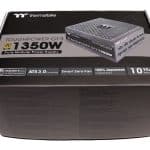
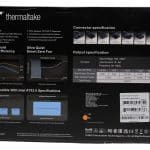
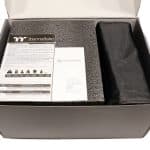


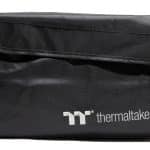

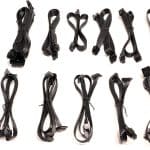

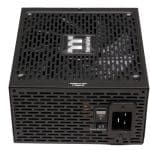
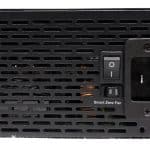
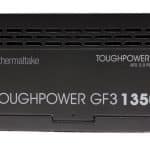
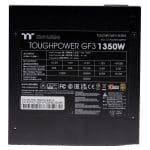
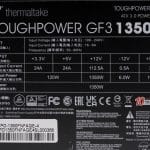
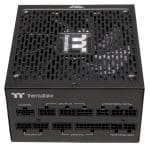
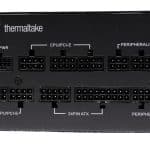
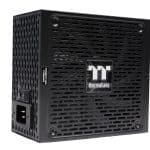
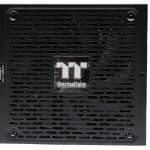
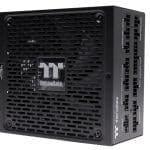
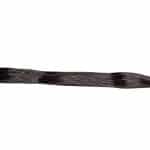

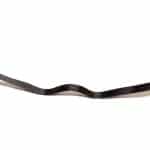




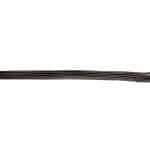
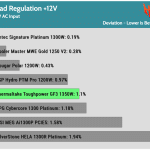
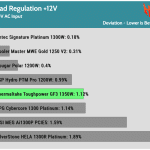
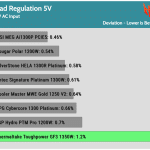
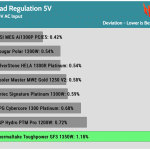
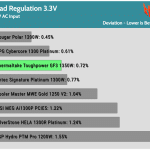
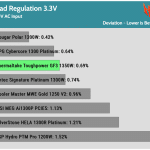
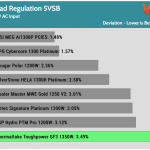
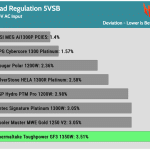
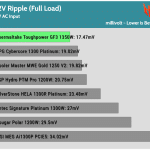
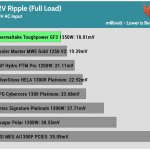
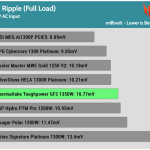
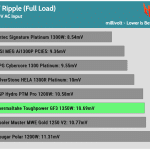
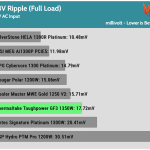
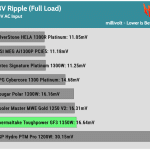
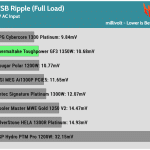
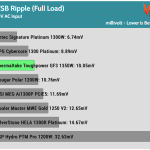
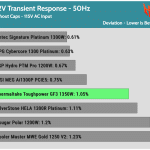

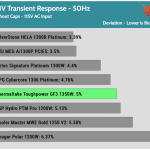
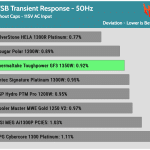

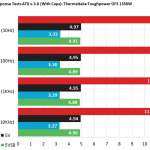
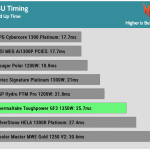
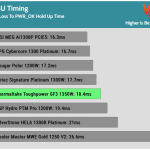
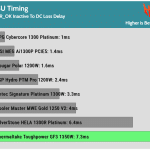
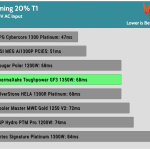
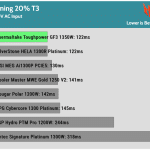
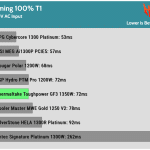
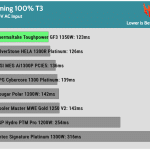
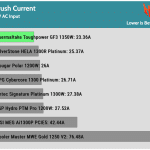
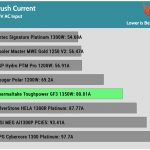
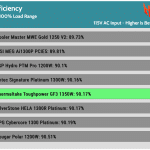
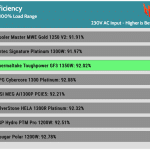

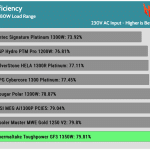
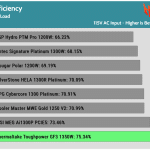
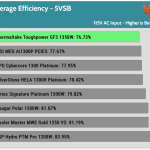
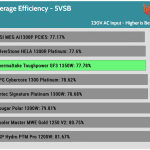
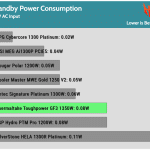


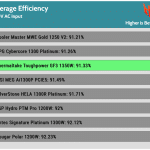
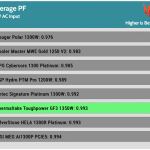
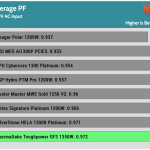
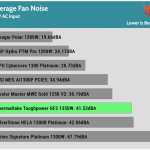
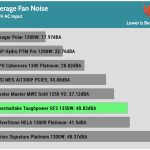
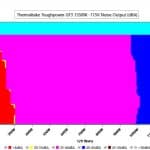
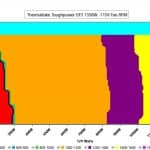

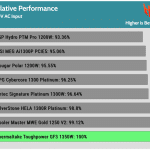
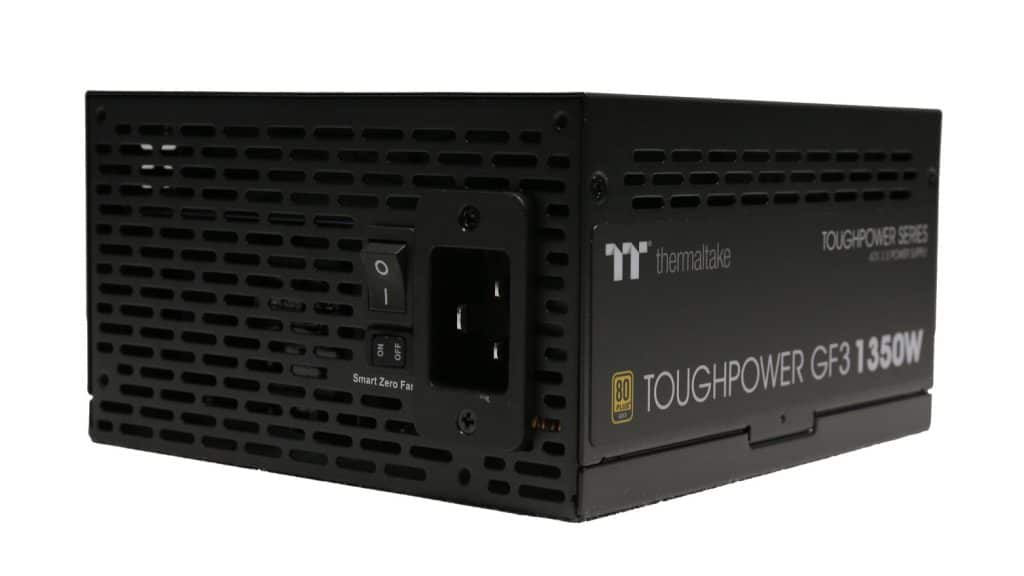


Very good article.
Next review is the 1650W monster yea?
It would be fantastic if you made a conclusion of the best performer/ efficiency
out of all 1000W+ Thermaltake GF3. I need to get one but do not know which to get.
Thanks for the solid details!
Excellent performance .
Still … the obvious question : what’s the official price for this unit ? ( i don’t think i’ve seen it anywhere not even at cons-pros )
I avoid putting prices because they change frequently, so people get confused. Only when the price is extraordinarily high or low, do I mention it. This one goes for 260 dollars now.
hmm ,my opinion is that the official price of the product should be mentioned regardless if this price is the actual market-price in order for the customer to be able to know how much deviation a certain product has between its official price Vs its market-price.
This way the customers can realise if the product’s retail-price is overinflated or not.
The retail prices do indeed change frequently ,that’s why i believe that we need a constant , such as the official price.